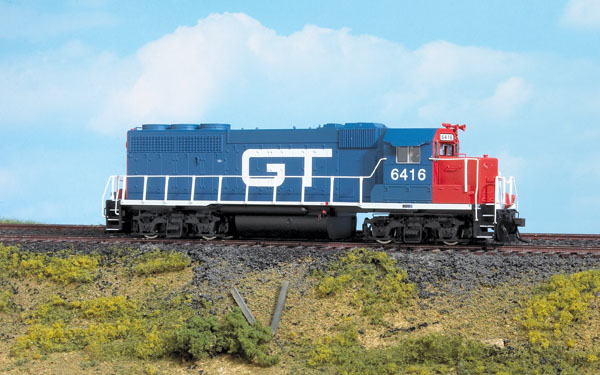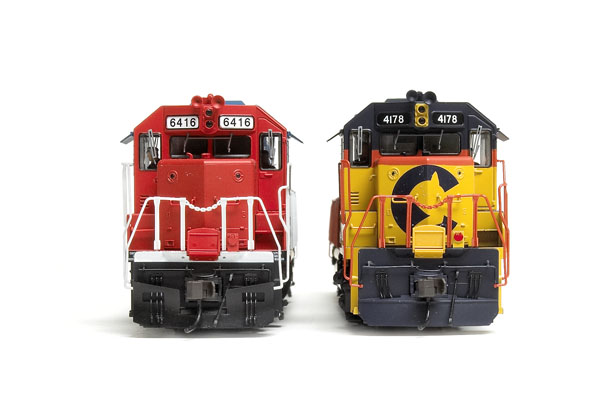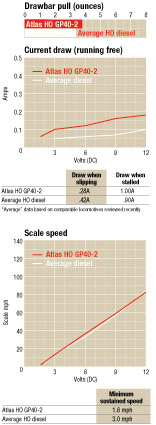General Motors’ Electro-Motive Division introduced the 3,000-h.p. GP40-2 in 1972, and 1,131 were built by the end of production in late 1978. Chessie System owned the largest fleet with 147 Phase I units that were split between its Baltimore & Ohio and Chesapeake & Ohio companies.
Our samples closely match the GP40-2 dimensions shown in the Simmons-Boardman 1974 Car and Locomotive Cyclopedia. The primary spotting details for Phase I GP40-2s are an engine water-level sight glass on the right rear side of the hood, a large electrical cabinet and straight air duct on the left side, and a lengthened battery compartment.
The different models include the appropriate long hood insert to simulate standard or extended-range dynamic brakes, or a plain roof. Separate parts are provided to detail the pilots with either m.u. hose storage boxes, a rock pilot, or a snowplow, depending upon the prototype. Both pilots are fitted with brake hoses, m.u. cables, and uncoupling levers. Fragile parts like the air horns, cab sunshades, radio antenna, and drop steps are packed separately for user installation.
All of the steps have see-through openings, and each locomotive has individually applied window wipers, metal grab irons, and handrails.
The paint on both of our samples is smooth with clean color breaks, and the lettering is clear and opaque. Colorful EMD builder’s plates are printed beneath the cab.
Mechanism. The GP40-2 is powered with a revised mechanism that’s compatible with the other recent-production Atlas GP38s and GP40s. Its die-cast metal frame now includes an A-frame bracket for a pair of speakers along with spaces for the five-pole can motor, printed-circuit board, turned brass flywheels, and acetal plastic universals and gearboxes.
Excellent early EMD GP or later modified GP truck sideframes are included where appropriate. All of the axles are driven, and all eight drivers pick up electricity.
The RP-25 contour wheelsets match the National Model Railroad Association standards gauge. Both trucks are wired to connectors that plug into the printed-circuit board.
Dual-mode electronics. We reviewed a Gold series model that includes a dual-mode decoder so the locomotive can run on either DCC or DC. A 41-page Diesel Locomotive Operation Manual explains the details of using QSI’s dual-mode system. However, Silver series (DC) models cannot operate in multiple with these models due to the higher starting voltage required by the sound system.
The QSI Quantum sound system is a full-function dual-mode DCC sound decoder. It delivers smooth control as well as excellent diesel sounds. This decoder also responds to QSI’s Quantum Analog Remote Control (QARC). On DC layouts you can operate and program sound functions using a QARC controller (not included) that can be easily added to most DC power packs.
The operating manual explains all of the QSI system’s operating and adjustment procedures. On DCC, the system uses 12 function keys to activate the decoder’s sounds and turn the lights on or off. Individual volume adjustments are available for all of the sounds.
When activated, the system gives verbal confirmations of changes in the DCC configuration variable (CV) settings. In case of a user programming error, a magnetic wand resets everything to the original factory default settings.
The locomotive comes factory programmed for regulated throttle control (RTC) that simulates momentum. This means it responds slowly to changes in the throttle settings. It can be reprogrammed to standard throttle control if you prefer more direct response.
The DC-only units include an NMRA-recommended 8-pin socket for easy conversion to DCC. Units with QSI sound have a different PC board plus a pair of speakers mounted over the rear truck.
Both versions produced identical 4-ounce drawbar pulls equivalent to 56 free-rolling HO freight cars on straight and level track.
Our samples came with standard size Accumate magnetic knuckle couplers. However, the model will accept other brands of magnetic knuckle couplers as well.
This smooth-running, medium-size locomotive is a versatile addi-tion to the Atlas line of HO locomotives. Its superb detailing, great performance, and excellent sounds would make it a standout on any layout.
Price: $149.95 Silver series DC only; $239.95 Gold series with sound and DCC decoder
Manufacturer
Atlas Model Railroad Co.
378 Florence Ave.
Hillside, NJ 07205
Road names (multiple road numbers): Grand Trunk Western; Alaska RR; Atlanta & West Point; Chessie System (B&O and C&O versions); Conrail; CSX; Denver & Rio Grande Western; Detroit, Toledo & Ironton; Florida East Coast; Georgia RR.; Reading; Richmond, Fredericksburg & Potomac; Western Ry. of Alabama; undecorated
Features
Accumate magnetic knuckle couplers (correct height)
Automatic dual-mode sound decoder with dual speakers for use on layouts with DC or Digital Command Control (DCC models)
Die-cast metal underframe
Drawbar pull: 4 ounces
Five-pole skew-wound motor with dual flywheels
Minimum radius: 18″
NMRA-recommended eight-pin DCC plug (DC models)
Painted crew figures
2,600- or 3,600-gallon fuel tank
Weight: 131/2 ounces

















I have two CN-GTW models and they are and they are great lokking and running!
Will there be any other roads available? For example NJ Transit
I would love to see The Frisco road name as I have two atlas GP38 with dcc but with out sound in the Frisco road name. These are great models that run well and look great. I am glad to see atlas is putting sound in these models.
Unfortunately, not a loco I'm inclined to purchase. It's not available in my favorite road name (Southern Pacific). Painting an undec is not an option for me.
very nice. The GP 40 is a common locomotive seen everywhere. I would love to see a Guilford road piant scheme sometime soon. I'm planning to do a contemporary layout of Mid- Maine> I'll be looking for Guilford equipment.
I started in model railroading back in 1972 and have just now gotten back into it. The technology adds such a sense of realism, and your website takes me back to the 1950's when the Sears and Roebuck Christmas "wish book" catalog arrived. Keep it up, you have a winner!
I purchased the gold edition,.I have wanted this engine and paint scheme for a long while, … it is most excellant.!! A work of kinetic art. I am really pleased. The craftsmanship is topshelf. I will be closely watching Atlas for more products. (Too many engines still ain't enough) I Have already locked in a h600 switcher.
I HAVE ALWAYS FOUND ATLAS ENGINES HEAD AND SHOULDERS ABOVE MOST OTHERS. I AM INTO DCC NOW SO
DON'T USE THE OLDER ATLAS ENGINES. MAY CONVERT LATER.
I HAVE A BACHMANN 4-6-0 DCC, TWO PROTOS, H10-44 AND
F7 A&B.
I have a CSX GP40-2 and it is a great running loco.Another Quality Atlas product we can depend on.
I purchased an Atlas Gold Series GP40-2 … had no problem entering a 4-digit address (I use CVP's Easy DCC) … runs GREAT and the sound is TERRIFIC!
I bought 3 gold series units, 2 CP and 1 Chessie. They run very smooth and are very controlable without altering from factory defaults. Only thing ive changed is address. The prog track booster i have makes this easier i suspect. Sound is impressive, especialy key 9, "sound of power", realy impressive with a consist of them. You'l want to turn 'em down abit as they will rattle your windws and ears! The sound IMO has got to be the most impressive there is at the moment. I would like to hear anything better! Only gripe i have with these is the strange chunky wind sheild wipers Atlas always use but thats easily corrected and im being picky. Its a great model and Il get more of them without a doubt.
Recently purchased a Gold Series CSX GP40-2 and was very impressed with the smooth operation and excellent sound system. The factory setting for the horn is a little to loud and causes some minor distortion and speaker vibration. I will lower the volumn some, but it sure does get everyones attention. Overall an excellent locomotive and I highly recommend it to anyone considering purchasing one.
I have the GT GP40 model and I am very happy with my purchase
I've purchased two of the Gold Series, two of the Silver series, and they are just excellent, in sound, operation, and easy programming and address chaging to 4 digits. The MRC Prodigy advanced 2/wireless system seems to love them as well. I love the accuracy of the sounds, but my wife is now looking for a basement for us with a house on it. Something about the house now sounding like a real railroad operating in it! Oh well. Keep them coming QSI and Atlas ! I love these new Gold and Silver series locomotives!
I love this engine but I also found the address difficult to change, after some time though I did get it done. I grew up around Grand Trunk and worked for them, this engine is a perfect match.
I just recently purchased two Atlas Gold series GP38-2 and if the GP40-2 are as good looking as the 38-2 then Atlas has a winner. However there is one draw back, that is in changing the locomotive address from factory set 3 to a four digit address. The instruction are very vague. QSI decoders are difficlut to address in four digits.
I purchased a GP40-2 w/sound recently and I agree with the review – it is an excellent engine. I have an NCE system and had no trouble changing to a 4 digit address when I programmed it on the main.
Sounds like an impressive model! But, where are the SP units?
Excellent locomotive. It looks, runs and sounds great. It also
works very well with my MRC Prodigy Advanced 2 DCC system.
Grand Trunk is my favorite.
I now have four of these, two Silver and two Gold and love them all. I love the Gyra light effect and the sound is great, as I'd expect from QSI. Atlas did it right with this one. Programming was very simple and straight forward. I also use Digitrax and Decoder Pro for all my programming. Four digit addressing was no problem, nor was setting all the sound volumns. Another smooth running loco, as I've come to expect from Atlas. I only wish QSI would make their sound decoders so the user could do manual rpm adjustments, like with Soundtraxx. Overall, an excellent offering.
I have 3 units, and had no problem setting the decoder addresses, all to 4 digits. I'm using Digitrax and used the instructions in the Digitrax manual.
My preference in DCC locomotives is always Atlas. I'm sure many more of these units could be sold if lettered SP. I hope I don't have to wait too long!
Will any Canadian road name schemes be offered?
Sounds like great locomotive – Can't afford one at this time. Wish I could!
Would like to be able to bye a Gold Serie with the "Union Pacific" road name.